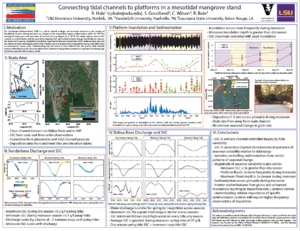Annualmeeting:2017 CSDMS meeting-110
Browse abstracts
Connecting tidal channels and platforms in a mesotidal mangrove stand
The Sundarbans National Forest (SNF) is a critical cultural, ecologic, and economic resource to the country of Bangladesh. Despite widespread land use changes in the surrounding region, sedimentation within the SNF has managed to keep pace with local rates of sea level rise (e.g., Rogers et al., 2013). This study explores some of the controls on sedimentation, with the goal of investigating their vulnerability to future change. Specifically, we examine the depth and frequency of platform inundation, suspended sediment concentration (SSC), sediment grain size, and the volume of water exchanged, and how these factors vary across time scales ranging from spring-neap tidal cycles through monsoon-dry season cycles. We observe pronounced seasonality, with the monsoon season experiencing the most frequent platform inundation, highest SSC, and greatest volume of water exchanged. Sediment grain size appears to vary spatially rather than seasonally, with a gradual decrease in grain size away from the primary tidal channel: the nominal sediment source. Of particular interest is how the seasonality of SSC varies between primary tidal channels like the Shibsa River, and the smaller tidal channels delivering sediment to the platform. On the Shibsa, spring tide SSC maxima during the monsoon and dry season are similar (~1.3 g/l), while neap tide SSC maxima are <0.5 g/l in either season. In channels within the SNF, monsoon spring tides exhibit peak SSC >1 g/l, while dry season SSC is always <0.5 g/l. Understanding why the source of local sediment (i.e., the primary tidal channel) behaves differently from the channels delivery that sediment to the platform presents an important knowledge gap that future research will examine in detail.

